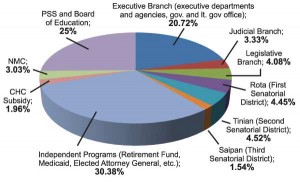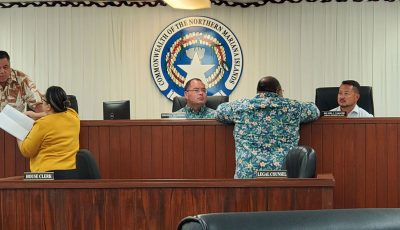A close look at how Legislature divvied up the $145.8M budget
Gov. Eloy S. Inos continues his review today of a “compromise” budget bill for fiscal year 2016 for a decision expected by tomorrow, a day before the fiscal year deadline of Sept. 30.
That compromise budget bill—technically called H.B. 19-86, HDG, SS1, CCSI—sees cuts in Inos-directed funds to the Marianas Visitors Authority; 5 percent salary raises for law enforcers; increases in the Legislature’s leadership account; salary raises for resident department heads on Tinian and Rota; and shifts the expenditure authority of Public School System operational funds to school principals.
Inos could either approve or veto the entire measure, or veto some select portions. Inos also has given marching orders to Cabinet members to prepare a list of “essential employees” should the government head into a government shutdown with no budget signed into law past Sept. 30.
Saipan Tribune learned that Cabinet members had inquired for a reported Attorney General’s opinion from 2010 on the definition of “essential” employees. While that Sept. 7, 2010, opinion could not be obtained as of press time, a memorandum issued by then-governor Benigno R. Fitial detailing an anticipated emergency order defining “essential services” was obtained.
That order, from Sept. 27 2010, expressed Fitial’s “regret” at the Legislature’s failure to get a budget done by Sept. 1. The order labeled “all” Commonwealth Ports Authority, Commonwealth Utilities Corp., and Public School System services as essential. It limited the Judiciary to one associate judge to conduct Gerstein and bail hearings, and one clerk to assist the associate judge.
For the Department of Community and Cultural Affairs, the order deemed employees under the Division of Youth Services and Child Protection Units to be essential.
The order provided an extensive list of “essential” Department of Public Health employees. This included clinic, surgery, communications, emergency, housekeeping, labor and delivery, and nursing services, among others.
The order labeled several units of the Department of Public Safety as “on-call.” That included the Criminal Investigation Bureau and Boating Safety Unit. The order limited to no more than nine firefighters per shift for the then-Fire Division, and limited to no more than eight officers per shift for the Police Division, among others.
The Northern Marianas College’s instructional and support staff were deemed “essential.”
Compromise budget
The proposed budget left the House and Senate with the following “compromises,” among others:
The conferees agreed to modify the Marianas Visitors Authority budget to fund the following: $1,802,403 for Department of Public Work streetlights, $200,000 for stationary x-ray machine for the Saipan airport; $225,000 for a container and loose cargo x-ray machine for the seaport; $75,000 for a handheld x-ray scanner for the seaport; and $200,000 for the Mayor of Saipan for cleanup and beautification projects.
-The conferees agreed to restore the Commonwealth Healthcare Corp.’s utilities subsidy in the amount of $2.02 million. It was first moved to fund Senate provisions like law enforcers’ pay raises and salary increases for department heads, among others.
-The conferees agreed to the Senate’s funding level for the first and second senatorial districts. That gives Rota $6,490,731, and Tinian $6,603,976. In the House’s original bill, Rota and Tinian got $5,967,774, and $5,967,734, respectively,
-The conferees agreed to the Senate version of the funding level for the Legislative Branch, which is $5,959,451. This is a boost from the House’s proposed $5,612,125. Under this, both House and Senate get a “leadership account” of $300,000—a 67-percent increase from the original House proposal of $179,387.
-The conferees agreed to fund the following salary increases: $62,000 for the special assistant for the Office of Management and Budget, from $54,000; 5-percent increase for all law enforcement officers; $45,000 for resident department heads for Rota and Tinian, from an annual pay of $36,000; and $45,000 for the deputy commissioners for Rota and Tinian.
-The conferees agreed to the Senate’s version of the reprogramming authority provision, which provides the CNMI governor with 100 percent reprogramming authority within the Executive Branch. This also gives 100 percent reprogramming authority to the chief justice of the Judiciary, and the same to the mayors of Tinian, Saipan, Rota, and the Northern Islands.
-The conferees agreed to delete in its entirety Section 713. Violations of spending limits, which would fine those who violates the budgeting act.
-The conferees agreed to allocate additional funds to the Judiciary for the creation of a Drug Court.
-The conferees agreed to the Senate version of Section 608. Emergency Operation Plan, which compensates “Response Activity Coordinators” for time and attendance. Compensation is straight time at the employee’s regular rate and charged to the government’s emergency account.
Budget breakdown
Under the Legislature’s proposed budget for next fiscal year, the Judiciary gets $4.86 million. The Legislature gets $4.96 million. The offices of the governor and lieutenant governor get $4.96 million.
The Department of Commerce gets $1.31 million. The Department of Community and Cultural Affairs gets $1.8 million. The Department of Correction gets $3.87 million. The Department of Fire and Emergency Services gets $2.97 million. The Finance Department gets $4.42 million. The Labor Department gets $850,153. Lands and Natural Resources gets $2.62 million. The Department of Public Safety gets $5.08 million. Public Works gets $2.34 million.
In total, the Executive Branch gets $30.22 million.
The first senatorial district, Rota, gets $6.49 million, while the second senatorial district, Tinian and Aguiguan, get $6.6 million. The third senatorial district, Saipan and the Northern Islands, gets $2.26 million.
Boards and commissions get $1.38 million.
Independent programs get $44.31 million. This includes money for retirees and Medicaid.
Under other programs, the Public School System gets $36.26 million while the Board of Education gets $190,194. The Northern Marianas College gets $4.42 million for general operations. The Marianas Visitors Authority gets $1. The CHC subsidy is allotted at $2.86 million.
The MVA, though, as the CNMI’s tourism agency, gets millions of funding from hotel occupancy tax earmarks and other sources. The hotel tax funding was projected and earmarked at about $12 million by Inos before the Legislature modified this program money and cut about $2.5 million for other agencies.
The general fund grand total is $145.82 million. For the first time, it gives 25 percent of total funds to PSS and the Board of Education, after the passage of a legislative initiative last year that mandated that share for PSS.




























